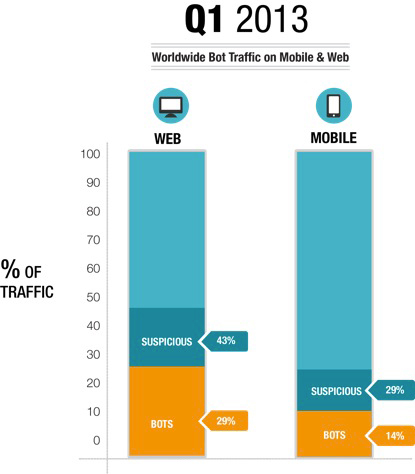 Machines have helped
make the buying and selling of inventory easier, but when they are told to buy and sell fraudulent inventory, a lot of money ends up stolen and or lost. New research from Solve Media shows that on
2013's current path, advertisers could lose more than $3 billion online and up to $1 billion in mobile due to ad fraud. In addition to ghost sites, publishers and advertisers also need to be wary of bots
that provide fraudulent clicks and impressions to boost sites up in indexing tools such as comScore.
Machines have helped
make the buying and selling of inventory easier, but when they are told to buy and sell fraudulent inventory, a lot of money ends up stolen and or lost. New research from Solve Media shows that on
2013's current path, advertisers could lose more than $3 billion online and up to $1 billion in mobile due to ad fraud. In addition to ghost sites, publishers and advertisers also need to be wary of bots
that provide fraudulent clicks and impressions to boost sites up in indexing tools such as comScore.
Ari Jacoby, Solve Media's CEO, spoke with RTM Daily about the issue. Jacoby said
that Solve Media gets all of their data from the security transactions they process daily. The report found that online, an astounding 40% of Q1 2013 traffic was suspicious, with 29% of it being
confirmed as bot traffic. On the mobile side, 29% of the traffic was suspicious, 14% confirmed as bots.
advertisement
advertisement
Jacoby said, "The advertising ecosystem has become so complex that it
has opened up plenty of opportunities for bad guys to cheat and steal." The advertising ecosystem he spoke of is a combination of a lot of money, a fast paced environment, and imbalanced information.
"That [combination] will always create a hotbed for fraud in any industry."
Citing the (potentially misquoted) quote from
Willie Sutton. Jacoby rhetorically asked, "Why do you rob banks? Because that's where the money is."
While the amount of suspicious online traffic (40%) didn't change from Q4
2012 to Q1 2013, Jacoby said that the issue has not improved, especially in mobile. In an earlier statement, Justin Somaini, chief trust officer at Box and a member of Solve Media's security advisory
council, said, "The barrier to entry for fraud and bots in mobile is almost  nonexistent."
nonexistent."
Jacoby agreed with that statement and
compared mobile security to a toddler when set side by side with desktop security. "…[B]ots frequently can masquerade as mobile users to take advantage of those lower security levels," he said.
Because mobile traffic has increased much faster than "anyone had originally anticipated," its security has a lot of catching up to do.
Another interesting find from Solve Media is
that 71% of Singapore's mobile traffic and 67% of the United Arab Emirates' showed up as suspicious. In the US, only - and "only" is used relatively, becuase it's still a high figure - 19% of mobile
traffic was suspicious. Jacoby said that he doesn't know why Singapore and the United Arab Emirates are linked to suspicious activity, but the findings are significant nonetheless.
Jacoby commented that self-policing when it comes to inventory is more important now than ever before. So what advice did he offer advertisers wanting to self-police and avoid selling ads
to non-humans? "Agencies and marketers can really seek out publishers that are taking a proactive stance…against online and mobile bot traffic." Basically, it all comes down to whether or
not humans make the right choices, which means, of course, that they need to do their homework.
At a potential $4 billion (combined) lost or stolen dollars in 2013, the bot issue
has risen to the surface. Obviously, none of this would be an issue if December rolled around and machines and robots had purchased $4 billion worth of goods throughout the year. However, our issues
would be much more significant than ad fraud at that point.